Hatter,
Vine House, Ann Street (and South
Street)
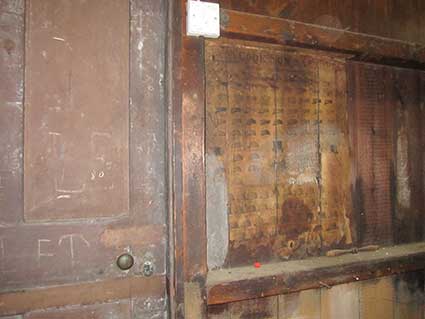 Photos courtesy Maureen Galvani
Photos courtesy Maureen Galvani
A partition wall at the rear of a former hat shop in Ann Street.
It looks as if DIYers have cleaned off their varnish and paint brushes
on the surface of an old poster...

'Season COOK, SON & CO.
1892
MEN'S BOYS
& GIRLS TWEED CLOTH & VELVET
CAPS.'
As this is specifically entitled in this way, one can assume
that the shop was definitely a 'hatter', whereas women's headgear would
have been sold by a milliner. The assumption is that the specialism
noted on the poster is carried over to the business of the shop.
Cook, Son & Co. was
one of the largest English wholesale clothing traders and drapers of
the late 19th century and early 20th century, distributing wares
throughout Great Britain and the colonies. The firm was created by
William Cook in 1819. In 1822 he went into partnership with his brother
James and in 1825 with Mr Gladstone. The firm moved to St Paul's Church
Yard in 1834, becoming 'Cook, Son & Co.' in 1852. William died in
1869. His son, Francis Cook, was head of the firm until his death in
1901and the company continued as a family business. Francis was enobled
in Portugal and in Britain and the company prospered; prior to his
death he was considered one of the three richest men in Britain. Sir
Francis Cook amassed a huge collection of art which was considered one
of the most important in England at the time. It included works by El
Greco, Titian, Van Eyck, Durer, Van der Weyden, Rubens, Rembrandt,
Gainsborough and Turner. Under Francis Cook the firm concentrated on
warehousing and distribution rather than manufacturing and employed
commercial travellers who exploited the recently built railway network
to make sales by visiting retailers with samples of the products. The
shop in Ann Street was one such retailer.
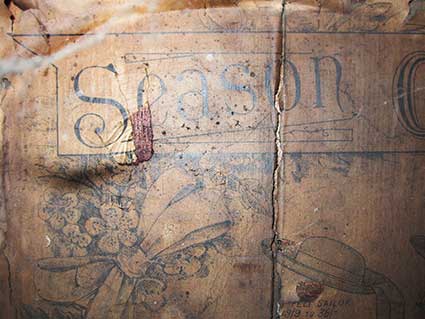
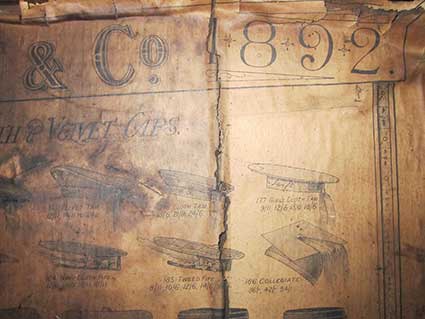
Products in the above details:
'Felt Sailor 18/9 to 36/-'
'military-style hats': 'Velvet Tam 12/11, 14/11 to 24/- ["PILOT" under
an anchor on hatband]
Cloth Tam 18/6. 21/9, 24/6 ["ECLIPSE" on hatband]
Girl's Cloth Tam 9/11, 12/6, 15/6, 18/6
Navy Cloth Fife 12/6, 14/9, 16/11, 18/11 [both Fifes with bow
and feather]
Tweed Fife 8/11, 10/6, 12/6, 14/6, 16/6'
'Collegiate 36/-, 42/-, 54/-'
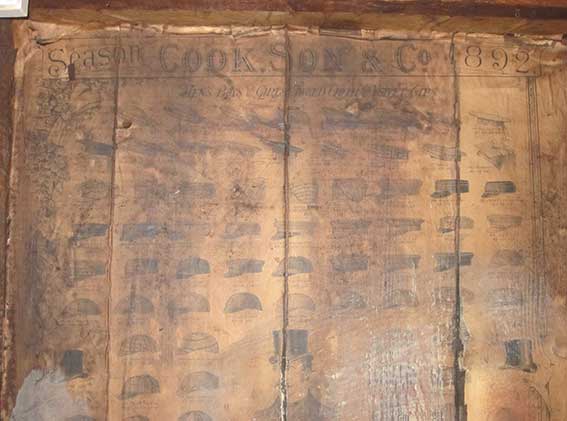
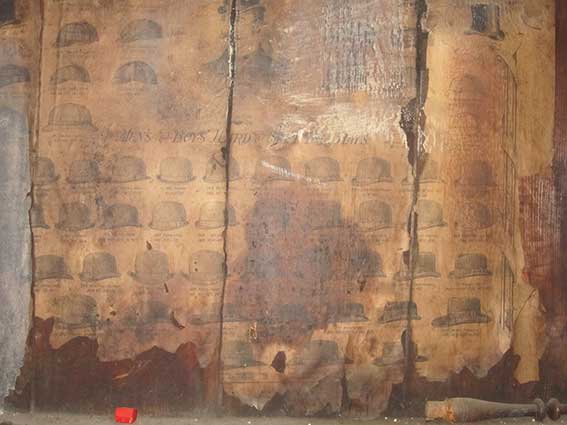
Halfway down: 'MEN'S
BOYS HARD & SOFT FOX[?] HATS'
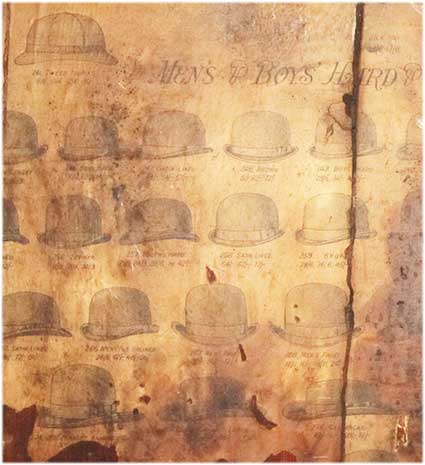
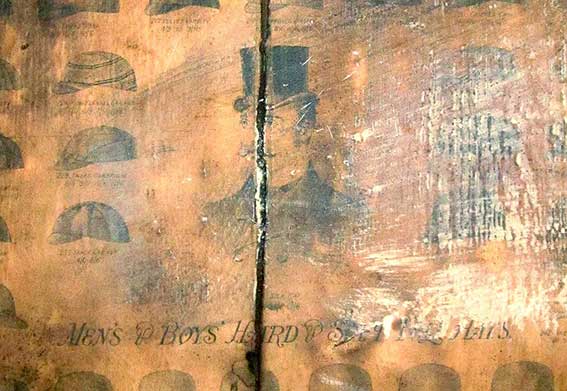
Some of the products advertised:-
'Tweed Tourist 8/6, 10/6, 12/6, 15/-'
Bowlers: 'Satin Lined 48/-, 54/-, 57/-
Brown 51/-, 62/-, 72/-
Youth's Hard 21/9, 24/9, 28/6 to 42/-
Men's Fur Lined 36/6, 42/-, 48/-, 56/-
Men's Paget 12/11, 16/11, 18/11, 24/-'
'Clerical 42/-, 51/-, 60/-, 72/-'
At fifty-six shillings (two pounds, sixteen shillings) for the
largest size of the Men's Fur Lined in, say, 1900 – that's £307.69 in
today's money – these hats were quite pricey. The cheapest of the same
model is thirty-six shillings and sixpence (one pound, sixteen
shillings and sixpence) – today that would be £200.55. However, at the
end of the Victorian era it would be almost unthinkable to go out and
about bare-headed. Unsurprisingly the quality of one's apparel said a
great deal about one's wealth and social standing.
As described above, the Cook, Son & Co. catalogue poster is
certainly published by a firm supplying wares to shops such as this. It
is thought that
hat-making and repairs may have been carried out on the premises, too.
Researching the trade directories:-
No entries found for ‘Milliners’, nor ‘Hatters’ for Ann Street (White’s
Directory of Suffolk, 1855).
45 Ann Street: Moffat, Andrew, travelling draper (‘drpr’) –
next entry is -Cumberland Street- which suggests
that no. 45 predates the terrace of houses down to the corner pub
(Stevens Directory, 1871-2).
45 Thompson,
S. (Stevens
Directory, 1881).
45
vacant
(Stevens Directory, 1885).
45
vacant
(Stevens Directory, 1894). [Note -
Miss E. Cook, milliner is
at 13 Orford Street (nearby).]
45 Oliver, John draper (Kelly’s Directory, 1906).
45 ditto
(Kelly’s Directory, 1909).
45 King, John
Oliver, John draper
(Kelly’s Directory, 1910).
45 King,
John
(Kelly’s Directory, 1912).
45 ditto
(Kelly’s Directory,
1913).
45 ditto
(Kelly’s Directory,
1914).
45 ditto
(Kelly’s Directory,
1915).
The entries above suggest that the address was a residence, rather than
a shop+residence. The current owner: "I believe there
was a teacher and his family of wife, six children and a maid living
here in approx 1870s so it's unlikely that the hat shop was operational
at that time. We noted that there was a travelling draper living here
in the early part of the 20th century."
'Vine House' – the story continues

In the Ipswich Journal of
July 23 1870 there is an advertisement entitled 'Flowers, flowers,
flowers'. 'This beautiful and elegant art taught in all its
branches by Mrs H. Rudland of London. Lessons given daily from 10 to 6
o'clock. French and German papers, and all the materials sold for
making them. Muslin wreaths and wedding orders executed on the shortest
notice. Vine House, Ann St, St Matthews, Ipswich.'

On September 5 1874 appears the announcement: 'To be sold: a
most commodious, substantial '.
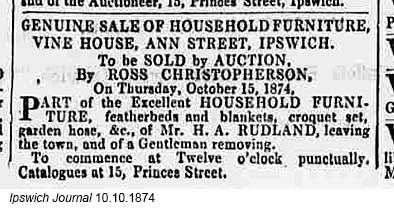
On October 10 1874 there is an advertisement for 'Genuine sale of
household furniture'.
Both these mention a Mr H. A. Rudland,
'leaving the town and of a Gentleman removing' so he appears to be the
former owner.
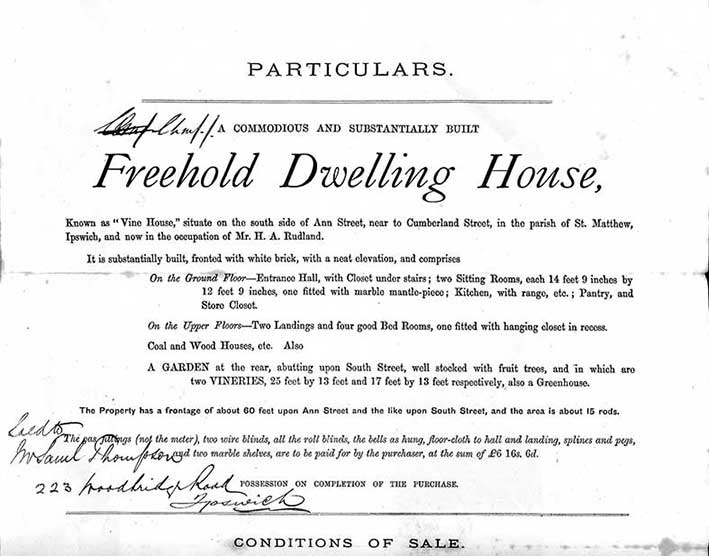
Here, in two parts, are the particulars of the auction of Vine
House in 1874. The handwritten note, added after the auction, reads:
'Sold to Mr Saml Thompson, 223 Woodbridge Road, Ipswich'. Kelly's Directory lists
Mr S. Thompson as still there in 1883,
although in 1885 it was vacant. Mr Samuel Thompson
is recorded as living there in Kelly's.
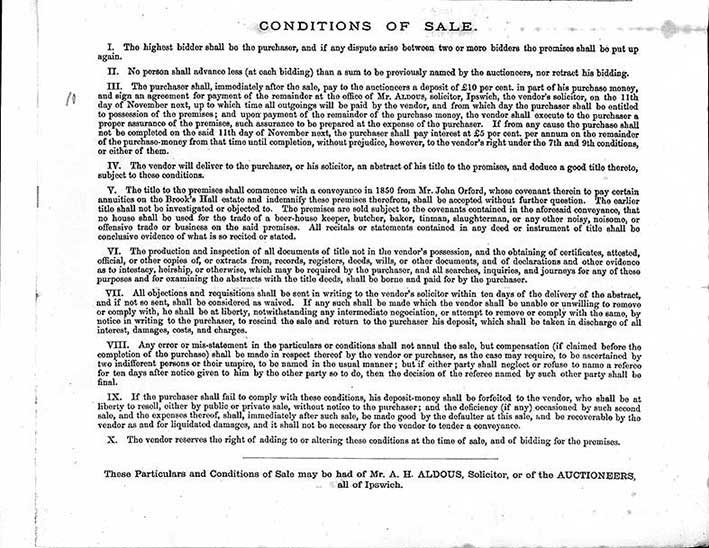
The 1881 census lists Samuel Thompson as a schoolmaster aged 50
born in Ipswich married to 44 year old Anna born in Mendlesham. They
had seven children:-
Robert Samuel, 23, clerk to a corn merchant;
Frederick, 17, apprentice to a cabinet maker;
Hugh, 16, draper;
Edith, 13, scholar;
Bernard, 11, scholar;
Henry, 5, scholar;
Helen, 3,
and a Domestic Servant: Jessie Boulton, 18, from East Bergholt.
There does not seem to be any mention of the hat shop on the
particulars so one wonders if the shop was a later addition. Mr John
Orford was presumably the original owner – perhaps he had the house
built after 1850. One also speculates that Orford Street, at the end of
Ann Street, might be named after him rather than the Suffolk port. His
name is mentioned in clause V. in Conditions
of sale (shown above):-
'The title to the premises shall commence with a conveyance in 1850
from Mr. John Orford, whose covenant therein to pay certain annuities
on the Brook's Hall estate and indemnify these premises therefrom,
shall be accepted without further question. The earlier title shall not
be investigated or objected to. The premises are sold subject to the
covenants contained in the aforesaid conveyance, that no house shall be
used for the trade of a beer-house keeper, butcher, baker, tinman,
slaughterman, or any other noisy, noisome or offensive trade or
business on the said premises. All recitals or statements contained in
any deed or instrument of title
shall be conclusive evidence of what is so recited or stated.'
For a 1902 map of the Ann Street area, see under 'South Street' on our Examples of Street
nameplates page.
For an ancient hatter sign, see our East
Bergholt page.
South Street
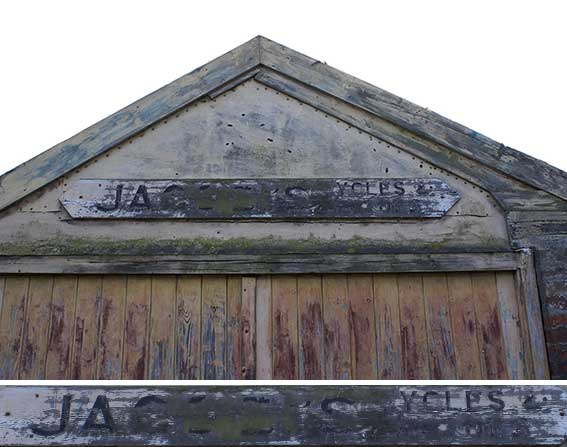
May 2025: 'Hard to make out – this is Jacobi's cycle and moped workshop
on South Street. No longer there, of course. The shop itself was on
Norwich Road*. Stephen Anderson'.
'JACOBI'S CYCLES & MOPEDS'
*For more shop signs in that area see our Serjeant's page.
Related pages:
Street nameplates; Street nameplates
on posts;
House
name plaque examples: Alston Road;
Bramford Road;
Cauldwell Hall Road; Cavendish Street; Marlborough Road; Rosehill area;
Ipswich & Suffolk Freehold Land
Society (F.L.S.); California
Street index;
Origins of street names
in Ipswich; Streets named after slavery
abolitionists.
Dated buildings list; Dated buildings examples;
Named
buildings list;
Named (& sometimes dated) buildings
examples.
Brickyards;
Ropewalks
Home
Please email any comments
and contributions by clicking here.
Search Ipswich
Historic Lettering
©2004
Copyright
throughout the Ipswich
Historic Lettering site: Borin Van Loon
No reproduction of text or images without express written permission
 Photos courtesy Maureen Galvani
Photos courtesy Maureen Galvani











